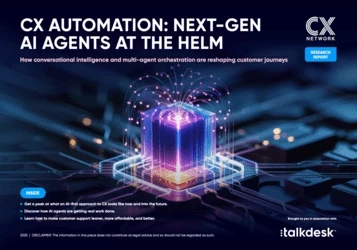How generative AI search is changing the customer journey
The launch of ChatGPT's Instant Checkout paves the way for digital shopping assistants and AI-first customer journeys
Add bookmark
The customer journey is ever-evolving. Gone are physical shopfronts with smiley sales reps and digital channels where CX experts insist, “we must meet customers where they are.”
Brands can forget investing heavily in social media, bombarding users with witty ads, influencer partnerships, or curated imagery. Now, we welcome generative AI – and it’s changing the game once again.

Don't miss any news, updates or insider tips from CX Network by getting them delivered to your inbox. Sign up to our newsletter and join our community of experts.
Generative AI and the modern customer journey
Generative AI tools like ChatGPT and Gemini are rapidly becoming the new front door to commerce. Instead of scrolling through feeds or browsing websites, consumers are turning to conversational assistants that compare, recommend, and complete purchases in a single, seamless dialogue – compressing discovery, consideration, and conversion into one personalized exchange.
For consumers, this shift offers convenience and clarity: less noise, more relevance, instant answers.
For brands, however, it brings opportunity and disruption. The AI interface has become the curator of choice, shaping which products and services surface in response to a query with built-in instant checkouts.
Visibility is no longer won through social engagement or ad spend; today, it hinges on data transparency, relevance, and algorithmic trust. As CX Network reported, 55 percent of consumers use generative AI to conduct research purchases, 47 percent for product recommendations, and 43 percent to find deals.
The research, published by Adobe Analytics, adds that shoppers guided by AI browse 12 percent more pages and bounce 23 percent less than those from traditional traffic sources – suggesting deeper exploration and stronger purchase intent. Post-purchase, intelligent systems automatically track orders, manage returns, and handle complaints, further streamlining the customer journey.
Using generative AI as a shopping assistant
Generative AI is a full-funnel ecosystem that is quickly becoming a digital personal shopper for the modern age. Replacing hours of browsing websites, reading reviews and scrolling social media, AI instantaneously creates shortlists complete with specifications, pros and cons, and direct links to buy.
By letting AI do the legwork, shoppers get a fully personalized experience with a machine that can interpret tone, context and intent, tailor recommendations dynamically, and suggest appropriate products according to bias and preference – making the interaction feel less like an algorithm and more like talking to a knowledgeable friend who understands your taste.
Representing a fundamental shift from passive browsing to intent-driven shopping, consumers no longer stumble upon products. Instead, they ask for exactly what they want. Altering the psychology of retail, buyers feel informed, efficient and in control – leaving brands competing for prominence within the AI’s trusted recommendations.
Success now requires engaging consumers at the moment of intent, inside the AI interface, rather than waiting for them to discover you. Yet this creates strategic challenges: if users bypass a brand’s website, how do companies get seen, build post-purchase relationships, tell their story, capture data, upsell or cross-sell? Brands must now optimize for comprehension over clicks and adapt their strategy to succeed in an AI-mediated shopping landscape.
Adding machine customers to the mix
From writing complaint emails to handling full chatbot conversations, people are delegating everyday “life admin” and customer-service tasks to AI agents. Requests range from simple to complex, positioning the AI as intermediaries, sitting between the human and the brand to submit queries, fill out forms, parse FAQs, and engage with chat or voice channels. What was once a straightforward human-to-brand interaction can now take the form of human-to-agent-to-brand.
Machine customers change the architecture of customer experience; brands can no longer assume or assign personas – today, the customer could be a bot acting on behalf of a human. Traditional engagement signals, such as browsing behaviour, time spent on site, or subtle emotional cues, can be diminished or lost entirely. Service channels that were designed to provide rich, human-centric experiences now need to accommodate machine interactions, emphasizing structured data, automated workflows, and API integrations.
Analysts warn that this evolution carries significant implications for revenue and retention strategies. Organizations risk losing a connection with their customers and opportunities to upsell and drive revenue, retention and growth. Brands must rethink how they measure engagement, deliver service, and maintain loyalty.
Agentic AI agents
In 2022, a chatbot negotiated a discount with a real customer service advisor demonstrating the potential of AI to act autonomously on behalf of a user. Although we didn’t call it agentic AI at the time, this marked the emergence of agentic capabilities – systems composed of multiple autonomous “agents” that can collaborate to complete complex, goal-oriented tasks with minimal human input.
Unlike traditional chatbots that respond to questions, agentic AI can reason, plan, and execute multi-step actions using tools, APIs and external data. In practice, that means moving from “find me a flight” to “book me a flight, reserve a hotel, and create an itinerary.” The system independently searches, compares and books options, checks calendars and applies loyalty accounts along the way.
By combining memory (to recall past interactions and preferences), reasoning (to break goals into sub-tasks), and autonomy (to act without supervision), agentic AI evolves from assistant to representative. For customers, this means convenience and efficiency; for brands, it signals a profound loss of control over discovery, messaging and loyalty.
Customer experience design will need to adapt and shift from human-centric to machine-readable ecosystems optimized for bots that parse, negotiate and transact. Metrics and KPIs must also evolve, tracking “chat-initiated purchases,” “AI-referral sales,” and “in-chat conversions.” And as always, the merchant’s backend dictates success: delays in fulfilment, poor returns or inadequate support can shatter the illusion of seamlessness, proving that operational excellence remains as critical as ever.
For brands, the implications are significant. When AI agents act as intermediaries, customer journeys become machine-moderated – and visibility depends less on marketing and more on machine-to-machine compatibility.
The future
Generative AI is already reshaping CX. Purchases are already conversational, immediate, and AI-mediated.
Clever campaigns no longer suffice; brands must embrace integration, optimize for AI-driven discovery, and rethink storytelling – or risk losing visibility, engagement, and insight in an increasingly agentic retail world.
Quick links
- CMA launches major crackdown on hidden online fees in first test of new consumer law
- Micro‑moments to macro impact: How hyper‑personalized gamified loyalty is changing the game
- How to navigate the hype around AI






























